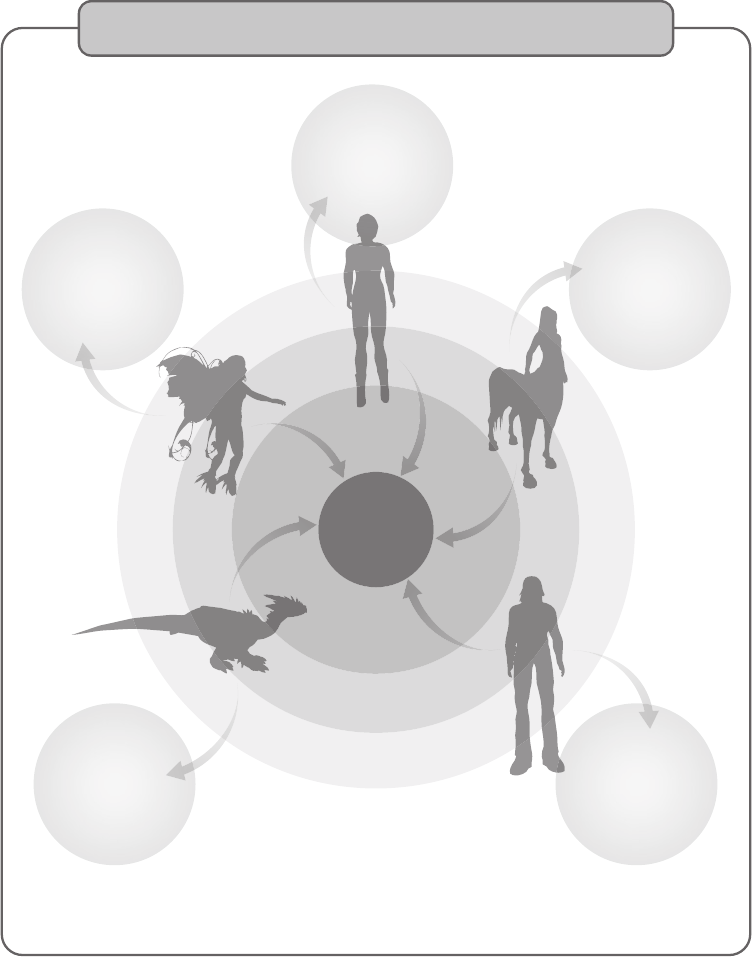237
12
Avatars and Nonplayer Characters
Henry Frankenstein: Look! It’s moving. It’s alive. It’s alive... It’s alive, it’s moving, it’s alive, it’s alive,
it’salive, it’s alive, IT’S ALIVE!
Victor Moritz: Henry—in the name of God!
Henry Frankenstein: Oh, in the name of God! Now I know what it feels like to be God!
Frankenstein, Universal Pictures, 1931, screenplay by John L. Balderston
12.1 AVATARS AND OUR SENSE OF SELF
Your avatar, no matter what manifestation you choose—human gure, re-breathing dragon, or anime
doll—is the center of your experience in the virtual world. As a human being with a self-reective mind
capable of observing your own thoughts and desires, the creation of your avatar in a virtual world gives you
the opportunity to experience social relationships in new ways, physical capacities that you may not have
(ying), and another perspective on self-identity/cultural identity (possibly as another gender). As you can see
from Figure12.1, the avatar is at the center of all things. As you log into the virtual world, the basic avatar
geometry takes on the body shape you have modied into your own virtual representation. Your virtual
body is stretched or compressed, tinted or made invisible. Meshes and objects are added to create interesting
things like wings and hooves. As you rez into existence, many layers are added. First, the shell of a shape is
put on, then a gender with its associated clothing and attachments, and nally the social and virtual barriers
that dene your visibility to others and availability for social contact.
Avatars are the common denominators, the hub of your subjective experience, and the heuristic frame-
work that allows you to observe relative scale and spatial qualities of the virtual environment. They are the
representative self through which you can participate in communication (text chat, voice chat), and they are
your cocreator (role-playing character) of the shared story in an MMORPG (massively multiplayer online
role-playing game).
Be careful about choosing an avatar in cyberspace. The psychological/physical connection to our virtual
selves runs deep in our minds. For many people, self-observation of their real body and thinking of their
avatar light up the same areas of their brains during scans [1]. Studies about the phenomenon of “body
transfer illusion” have demonstrated that a threat to your avatar’s body, no matter how differently it looks
from your actual body, will elicit the same physiological response as a threat to your real body [2].
At the Stanford Virtual Human Interaction Lab (http://vhil.stanford.edu/), there are several research pro-
grams that study the body transfer illusion as well as other avatar/human-related events. In one experiment,
they found that people using avatars with superpowers to save a lost diabetic child in the virtual scenario
would demonstrate a faster response to helping one of the lab assistants pick up a bunch of spilled pens after
their virtual session was over [3]. The scientists at the lab have found that more ecological behavior (such as
using fewer paper napkins) will be demonstrated by people after they participate as virtual lumberjacks in
the toppling of a virtual tree. Testing results have also shown that composite avatars that blend your real-life
face with a politician’s face will make you more likely to vote for that politician.

238 Virtual World Design
Avatar silhouettes (clockwise order from the top right):
Linden Labs - Female Centaur (created by Erin Talamasca - Hoof It!);
Linden Labs Musician;
Linden Labs Dragonet;
Flower Fairy (created by June Dion - Bare Rose)
Avatars are at the Center of Experience in a Virtual Environment
You
Communication
Who in the world
am I going to chat
with today?
Relative Scale
How big/small am I?
Role to Play
Pirate or princess,
fireman or fairy?
Location
Spatial
Awareness
Where am I
standing now?
Subjective
Experience
What is my
avatar
experiencing?
Gender and
Movement
Social and
Virtual Visibility
Avatar Shell
FIGURE 12.1 Diagram showing the relationship of the avatar to the user in a virtual world. The avatar creates a
layered framework that encompasses a range of experience including relative scale observation, communication, spatial
awareness, subjective experience, and role playing.
Get Virtual World Design now with the O’Reilly learning platform.
O’Reilly members experience books, live events, courses curated by job role, and more from O’Reilly and nearly 200 top publishers.

